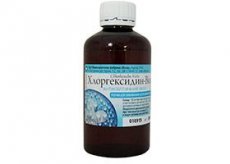Medical expert of the article
New publications
Preparations
Chlorhexidine
Last reviewed: 03.07.2025

All iLive content is medically reviewed or fact checked to ensure as much factual accuracy as possible.
We have strict sourcing guidelines and only link to reputable media sites, academic research institutions and, whenever possible, medically peer reviewed studies. Note that the numbers in parentheses ([1], [2], etc.) are clickable links to these studies.
If you feel that any of our content is inaccurate, out-of-date, or otherwise questionable, please select it and press Ctrl + Enter.

Indications Chlorhexidine
It is used to prevent the development of venereal pathologies (such as gonorrhea with syphilis, as well as chlamydia with trichomoniasis and ureaplasmosis) and complications of an infectious and inflammatory nature in gynecological and obstetric practice: before gynecological operations, as well as before an abortion or childbirth; also before and after the installation of an IUD in the uterus, as well as before an intrauterine examination and before and after diathermocoagulation of the cervix.
Treatment of cervical erosion, colpitis, and bacterial vaginosis.
Release form
Available in pessaries with 5 pieces inside a blister. A separate pack contains 2 blister plates.
Chlorhexidine-health
Chlorhexidine-health is a disinfectant medicine, antiseptic. It is produced in the form of a solution applied externally.
It is used to prevent STDs (gonorrhea, chlamydia, as well as syphilis, ureaplasmosis and trichomoniasis, genital herpes).
The solution is also used to disinfect infected surfaces of burns and wounds with pus. In addition, to eliminate infectious processes on the mucous membranes and skin in obstetric, surgical, urological (urethroprostatitis with urethritis), as well as gynecological and dental practice (for irrigation and rinsing with aphthae, alveolitis with gingivitis and periodontitis with stomatitis).
For disinfection of minor injuries (minor burns, scratches and wounds).
Chlorhexidine-kr
Chlorhexidine-kr is available in a 100 ml container equipped with a special nozzle. Inside the package there is 1 container.
Pharmacodynamics
Chlorhexidine gluconate has a powerful and rapid effect on such gram-negative and gram-positive microbes as Treponema pallidum, Chlamydia, Ureaplasma spp., Gonococcus and Trichomonas vaginalis.
Weak sensitivity to the drug is found in strains such as pseudomonas and proteus.
Resistance is exhibited by acid-resistant bacteria, fungi, bacterial spores and viruses.
Dosing and administration
Pessaries should be inserted intravaginally.
Mode of application: it is necessary to insert 1 pessary during the period of 7-10 days, 1-2 pieces per day (the duration of the course depends on the nature of the pathology). If necessary, the course is extended (maximum - 20 days).
For the prevention of STIs: insert 1 pessary once after sexual intercourse (no more than 2 hours).
During pregnancy. Taking into account the severity of the infection, the results of bacteriological tests, and the risk of miscarriage, the medicine is used 1 piece 1-2 times a day (in monotherapy or in combination therapy). The duration of use is within 5-10 days.
During lactation, it is permitted to use the drug in standard recommended dosages.
Use Chlorhexidine during pregnancy
It is allowed to use Chlorhexidine during lactation and pregnancy.
Shelf life
Chlorhexidine can be used for a period of 2 years from the date of manufacture of the drug.
 [ 44 ]
[ 44 ]
Attention!
To simplify the perception of information, this instruction for use of the drug "Chlorhexidine" translated and presented in a special form on the basis of the official instructions for medical use of the drug. Before use read the annotation that came directly to medicines.
Description provided for informational purposes and is not a guide to self-healing. The need for this drug, the purpose of the treatment regimen, methods and dose of the drug is determined solely by the attending physician. Self-medication is dangerous for your health.

